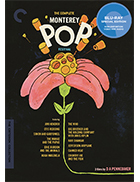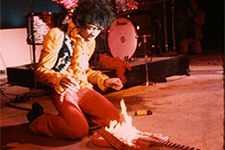| Director: D.A. Pennebaker | | Features: The Mamas and the Papas, Canned Heat, Simon and Garfunkle, Big Brother and the Holding Company, Janis Joplin, Jefferson Airplane, Eric Burdon and The Animals, Country Joy and the Fish, The Who, Otis Redding, Jimi Hendrix, Ravi Shankar | | MPAA Rating: NR | | Year of Release: 1968 | | Country: U.S. |  |
|  When the First Annual Monterey International Pop Festival was organized by music producer Lou Adler and John Philips, the frontman for the folk-pop band The Mamas & the Papas, there had never been anything like it before. While we now live in an era in which pop/rock festivals are ubiquitous all over the world, there had never been such a gathering prior to the summer of 1967 (which would come to be dubbed the “Summer of Love”). Thus, the Monterey festival was revolutionary not only for the way it established one of the first major stakes in what would become known as “The Sixties,” but it gave credence to the idea that pop music could be art. The three-day festival, which took place at the Monterey County Fairgrounds in northern California, was filmed by documentarian D.A. Pennebaker, who was initially hired with the idea that his resulting film would be shown on network television. At the time, Pennebaker was a proponent of Direct Cinema, a specific style of documentary filmmaking that privileged the camera’s observational, rather than intrusive, nature. He had already captured part of the era’s zeitgeist with his 1967 Bob Dylan documentary Dont Look Back, but he had never made a concert film before. In fact, prior to Monterey Pop, no one had made a concert film before. Like the festival it recorded, the film became a pioneering work for others to emulate. Despite its brief 80-minute running time, Monterey Pop indelibly captures the spirit of the festival and also displays some of the most powerful moments of rock music ever captured on film. The simple, quite rhythms of Simon & Garfunkle’s “The 59th Street Bridge Song” (with its soft refrain about “feeling groovy”) stands in stark contrast to The Who’s loud, rebellious anthem “My Generation,” which they conclude by smashing their instruments, an act of violent defiance the crowd was clearly not expecting. The first performance we see is The Mamas & The Papas singing “California Dreamin’,” which might as well be the festival’s theme song, and the last performance we see is Ravi Shankar’s “Raga Bhimpalasi,” whose rapid-fire sitar is a reminder that the word international in the festival’s title means something. In-between are performances by such ’60s luminaries as Jefferson Airplane, Janis Joplin (performing with her original group, Big Brother & The Holding Company), and Otis Redding, who was performing in front of a predominantly white audience for the first time and subsequently became an overnight star. The film reaches its climactic moment, though, with Jimi Hendrix’s iconic performance of “Wild Thing,” which begins with his revving the distortion on his electric guitar like a motorcycle engine and ends with him literally making love to the instrument before setting it on fire, a moment that was immortalized as a Rolling Stone cover image. As a result, Hendrix solidified his star status as one of rock music’s most electrifying and original performers. One of the most intriguing things about the festival, as it is depicted in Monterey Pop, is that it never seems particularly large. It has a tight, intimate quality that even wide shots of large audiences can’t quite dispel. Although records indicate that some 200,000 people attended the festival, after watching the film you would swear there were only a couple thousand there at most. The sense of intimacy is enhanced by Pennebaker’s decision to focus heavily on close-ups and medium close-ups of both the performers and the people in the audience. Monterey Pop frequently plays like a study in faces. The observational nature of Pennebaker’s Direct Cinema approach has its limitations, though, as we see virtually nothing of the behind-the-scenes activities that made the festival possible (only a brief scene of John Phillips on the phone and some shots of the stage being constructed), and there are no interviews with any of the performers. What were they thinking during this momentous event? Did they know they were making history? Such questions are not answered because Pennebaker never attempts to answer them. Instead, he focuses on the music and lets it speak in its own clear, loud voice. At its best, Monterey Pop captures a moment that might otherwise have been lost in time. As the apex of the Summer of Love and a moment of unprecedented coalescence for rock music, the festival was a high point of the 1960s, a pinnacle of possibilities that were ultimately, sadly doomed. Within two years of the film’s release in 1968, the Mamas & the Papas had broken up, Otis Redding, Janis Joplin, and Jimi Hendrix were all dead, and the disastrous Rolling Stones concert at Altamont (captured in the extraordinary 1970 documentary Gimme Shelter) had literally shut the door on the perceived power of peace, love, and happiness. But, for those three days in June of 1967, it was a dream that could be had, and Monterey Pop captures it beautifully. | The Complete Monterey Pop Festival Criterion Collection Blu-ray Set | | This Blu-ray boxset contains Monterey Pop (1968) and its two companion pieces, Jimi Plays Monterey (1986), and Shake! Otis at Monterey (1986). Monterey Pop is also available separately as a stand-alone Blu-ray. | | Aspect Ratio | 1.33:1 | | Audio | English DTS-HD Master Audio 5.1 surroundEnglish DTS-HD Master Audio 2.0 stereo | | Subtitles | English | | Supplements | Two hours of performances not included in Monterey Pop, from the Association, Big Brother and the Holding Company, the Blues Project, Buffalo Springfield, the Paul Butterfield Blues Band, the Byrds, Country Joe and the Fish, the Electric Flag, the Grateful Dead, Jefferson Airplane, Al Kooper, the Mamas and the Papas, the Steve Miller Blues Band, Moby Grape, Laura Nyro, Quicksilver Messenger Service, Simon and Garfunkel, Tiny Tim, and the WhoAudio commentary on Monterey Pop from 2002 by director D.A. Pennebaker and festival producer Lou AdlerAudio commentary from 2002 on Jimi Plays Monterey by music critic Charles Shaar MurrayTwo audio commentaries from 2002 on Shake! Otis at Monterey by music critic Peter GuralnickNew video interviews with Adler and PennebakerChiefs (1968), a short film by Richard Leacock, which played alongside Monterey Pop in theatersVideo interviews from 2002 with Adler and Pennebaker and with Phil Walden, Otis Redding’s manager1987 interview with Pete Townshend on Monterey and Jimi HendrixAudio interviews with festival producer John Phillips, festival publicist Derek Taylor, and performers Cass Elliot and David CrosbyPhoto-essay by Elaine MayesFestival scrapbookTrailers and radio spotsInsert book featuring essays by critics Michael Chaiken, Armond White, David Fricke, Barney Hoskyns, and Michael Lydon | | Distributor | The Criterion Collection | | SRP | $69.95 | | Release Date | December 12, 2017 | | | COMMENTS | | Criterion’s Blu-ray of Monterey Pop features a brand-new 4K digital transfer from the original 16mm A/B camera reversal negative that was supervised by director D. A. Pennebaker. The transfer maintains the film’s grain structure and reflects some of the limitations of 16mm, especially the sequences shot at night (when the performers are lit entirely with red lights, some of the details tend to wash out a bit in long shots). However, this is a genuine reflection of the way the film should look. Digital restoration has removed most damage and dirt, including a few vertical lines that were present on the 2009 Criterion DVD. Compared to the DVD, the Blu-ray looks much brighter, richer, and more detailed, and colors have a substantially stronger vibe. The other films in the set look fantastic, as well. Jimi Plays Monterey and Shake! Otis at Monterey were both transferred from the 35mm duplicate negatives and digitally restored. Given that the concert footage in the film was blown up to 35mm, their images are not as good as Monterey Pop, but they still look pretty great. Of course, as with the earlier DVDs, one of the real selling points are the phenomenal remixed soundtracks, which were done by record producer and sound engineer Eddie Kramer, who has worked with the likes of Led Zeppelin, The Rolling Stones, and Jimi Hendrix. Working with the original 1-inch 8-track tape recordings from the festival, Kramer has produced impressive 5.1-track mixes for all three films that are presented in DTS-HD Master Audio. The music takes on new scope and power with the expanded mix, as does the enveloping nature of the audience applause (which was made possible because there was a separate microphone at the back recording the crowd). The disc includes a tech-specific essay by Kramer about how he went about remixing the sound. For purists, though, the original, unremixed stereo soundtracks are included, as well as remixed stereo soundtracks. The Blu-ray contains all of the supplements that were included on the previous Criterion DVD, plus a whole lot more. From the earlier disc we get director D.A. Pennebaker and festival co-producer Lou Adler reunited for both a screen-specific audio commentary and a 30-minute video interview. Both offer fascinating behind-the-scenes information about the organization of the festival and the creation of the film. There are all kinds of intriguing tidbits, including a part where Pennebaker talks about how none other than Truman Capote helped him make a major editing decision. Jimi Plays Monterey has a commentary by music critic and historian Charles Shaar Murray, while Shake! Otis at Monterey has two commentaries, both by music critic and historian Peter Guralnick (one focuses specifically on each song while the other is a more general overview of Redding’s career). More information is available in archival audio interviews with festival co-producer John Phillips, festival publicist Derek Taylor, and performers Cass Elliot and David Crosby. We also get the same fascinating, comprehensive collection of photographs by Elaine Mayes and a 12-minute photo essay in which Mayes talks about some of her most famous photographs. There is also the reproduction of the original festival program (it includes an extremely helpful “text” option so you can actually read the articles and descriptions), the original theatrical trailer, and five radio spots. The new stuff kicks off with a bonus Blu-ray disc containing two hours of performances not included in Monterey Pop from the Association, Big Brother and the Holding Company, the Blues Project, Buffalo Springfield, the Paul Butterfield Blues Band, the Byrds, Country Joe and the Fish, the Electric Flag, the Grateful Dead, Jefferson Airplane, Al Kooper, the Mamas and the Papas, the Steve Miller Blues Band, Moby Grape, Laura Nyro, Quicksilver Messenger Service, Simon and Garfunkel, Tiny Tim, and the Who. It is an amazing compilation of performances, with the image transferred from 16mm reversal prints and the soundtracks given a new remix from the original concert recordings. That alone would make the set worth purchasing, but we also get new video interviews with Adler (12 min.) and Pennebaker (15 min.); Chiefs (1968), a 20-minute short film by Richard Leacock that played alongside Monterey Pop in theaters; and a 1987 interview with Pete Townshend on Monterey and Jimi Hendrix. The thick insert booklet contains essays by critics Michael Chaiken, Armond White, David Fricke, Barney Hoskyns, and Michael Lydon. |
Copyright © 2017 James Kendrick Thoughts? E-mail James Kendrick All images copyright © The Criterion Collection |




 (3.5)
(3.5)

